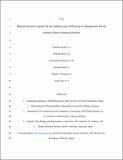Files in this item
Human ostensive signals do not enhance gaze following in chimpanzees, but do enhance object-oriented attention
Item metadata
| dc.contributor.author | Kano, Fumihiro | |
| dc.contributor.author | Moore, Richard | |
| dc.contributor.author | Krupenye, Christopher. | |
| dc.contributor.author | Hirata, Satoshi | |
| dc.contributor.author | Tomonaga, Masaki | |
| dc.contributor.author | Call, Josep | |
| dc.date.accessioned | 2019-07-25T23:40:54Z | |
| dc.date.available | 2019-07-25T23:40:54Z | |
| dc.date.issued | 2018-09 | |
| dc.identifier | 255042997 | |
| dc.identifier | 809724d0-92d1-4bbc-97e0-ab95b1e1d94e | |
| dc.identifier | 85050664094 | |
| dc.identifier | 000441446100009 | |
| dc.identifier.citation | Kano , F , Moore , R , Krupenye , C , Hirata , S , Tomonaga , M & Call , J 2018 , ' Human ostensive signals do not enhance gaze following in chimpanzees, but do enhance object-oriented attention ' , Animal Cognition , vol. 21 , no. 5 , pp. 715-728 . https://doi.org/10.1007/s10071-018-1205-z | en |
| dc.identifier.issn | 1435-9448 | |
| dc.identifier.other | ORCID: /0000-0002-8597-8336/work/47136594 | |
| dc.identifier.other | ORCID: /0000-0003-2029-1872/work/47136658 | |
| dc.identifier.uri | https://hdl.handle.net/10023/18170 | |
| dc.description | Financial support came from Ministry of Education, Culture, Sports, Science and Technology [K-CONNEX to FK], Japan Society for Promotion of Science KAKENHI 26885040, 16K21108, and 18H05072 to FK, 26245069, 16H06301, 16H06283, and 18H05524 to SH, 15H05709, 16H06238, and JSPS-CCSN to MT, and JSPS-LGP-U04 and Great Ape Information Network to SH and MT, and the European Research Council [SOMICS 609819 to JC]. | en |
| dc.description.abstract | The previous studies have shown that human infants and domestic dogs follow the gaze of a human agent only when the agent has addressed them ostensively—e.g., by making eye contact, or calling their name. This evidence is interpreted as showing that they expect ostensive signals to precede referential information. The present study tested chimpanzees, one of the closest relatives to humans, in a series of eye-tracking experiments using an experimental design adapted from these previous studies. In the ostension conditions, a human actor made eye contact, called the participant’s name, and then looked at one of two objects. In the control conditions, a salient cue, which differed in each experiment (a colorful object, the actor’s nodding, or an eating action), attracted participants’ attention to the actor’s face, and then the actor looked at the object. Overall, chimpanzees followed the actor’s gaze to the cued object in both ostension and control conditions, and the ostensive signals did not enhance gaze following more than the control attention-getters. However, the ostensive signals enhanced subsequent attention to both target and distractor objects (but not to the actor’s face) more strongly than the control attention-getters—especially in the chimpanzees who had a close relationship with human caregivers. We interpret this as showing that chimpanzees have a simple form of communicative expectations on the basis of ostensive signals, but unlike human infants and dogs, they do not subsequently use the experimenter’s gaze to infer the intended referent. These results may reflect a limitation of non-domesticated species for interpreting humans’ ostensive signals in inter-species communication. | |
| dc.format.extent | 6187683 | |
| dc.language.iso | eng | |
| dc.relation.ispartof | Animal Cognition | en |
| dc.subject | Domestication | en |
| dc.subject | Gaze following | en |
| dc.subject | Great ape | en |
| dc.subject | Ostensive signals | en |
| dc.subject | Referential communication | en |
| dc.subject | BF Psychology | en |
| dc.subject | QL Zoology | en |
| dc.subject | RC0321 Neuroscience. Biological psychiatry. Neuropsychiatry | en |
| dc.subject | DAS | en |
| dc.subject.lcc | BF | en |
| dc.subject.lcc | QL | en |
| dc.subject.lcc | RC0321 | en |
| dc.title | Human ostensive signals do not enhance gaze following in chimpanzees, but do enhance object-oriented attention | en |
| dc.type | Journal article | en |
| dc.contributor.sponsor | European Research Council | en |
| dc.contributor.institution | University of St Andrews. School of Psychology and Neuroscience | en |
| dc.contributor.institution | University of St Andrews. Centre for Social Learning & Cognitive Evolution | en |
| dc.identifier.doi | 10.1007/s10071-018-1205-z | |
| dc.description.status | Peer reviewed | en |
| dc.date.embargoedUntil | 2019-07-26 | |
| dc.identifier.url | https://link.springer.com/article/10.1007/s10071-018-1205-z#SupplementaryMaterial | en |
| dc.identifier.grantnumber | 609819 | en |
This item appears in the following Collection(s)
Items in the St Andrews Research Repository are protected by copyright, with all rights reserved, unless otherwise indicated.

